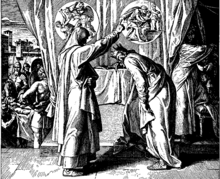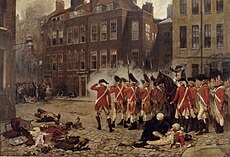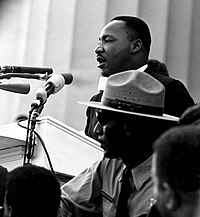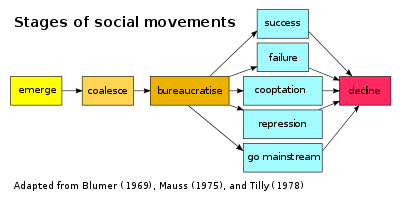Some religions consider blasphemy to be a religious crime.
As of 2012, anti-blasphemy laws existed in 32 countries, while 87
nations had hate speech laws that covered defamation of religion and
public expression of hate against a religious group. Anti-blasphemy laws are particularly common in Muslim-majority nations, such as those in the Middle East and North Africa, although they are also present in some Asian and European countries.
Etymology
The word "blasphemy" came via Middle English blasfemen and Old French blasfemer and Late Latin blasphemare from Greek βλασφημέω, from βλάπτω "injure" and φήμη "utterance, talk, speech". From blasphemare also came Old French blasmer, from which English "blame" came. Blasphemy: 'from Gk. blasphemia "a speaking ill, impious speech, slander," from blasphemein "to speak evil of."'
"In the sense of speaking evil of God this word is found in Ps. 74:18;
Isa. 52:5; Rom. 2:24; Rev. 13:1, 6; 16:9, 11, 21. It denotes also any
kind of calumny, or evil-speaking, or abuse (1 Kings 21:10 LXX; Acts 13:45; 18:6, etc.)."
Blasphemy laws
Local restrictions
Fines and restrictions
Prison sentences
Death sentences
In some countries with a state religion, blasphemy is outlawed under the criminal code.
In some states, blasphemy laws are used to protect the religious
beliefs of a majority, while in other countries, they serve to offer
protection of the religious beliefs of minorities.
As of 2012, 33 countries had some form of anti-blasphemy laws in their legal code.
Of these, 21 were Muslim-majority nations – Afghanistan, Algeria,
Bahrain, Egypt, Indonesia, Iran, Jordan, Kuwait, Lebanon, Malaysia, the
Maldives, Morocco, Oman, Pakistan, Qatar, Saudi Arabia, Somalia, Sudan,
Turkey, the UAE and the Western Sahara. Blasphemy is treated as a capital crime (death penalty) in some Muslim nations.
In these nations, such laws have led to the persecution, lynchings,
murder or arrest of minorities and dissident members, after flimsy
accusations.
The other twelve nations with anti-blasphemy laws in 2012 included India and Singapore, as well as Christian majority states, including Denmark (abolished in 2017), Finland, Germany, Greece, Ireland (abolished in October 2018), Italy, Malta (abolished in 2016), the Netherlands (abolished in 2014), Nigeria, and Poland. Spain's "offending religious feelings" law is also, effectively, a prohibition on blasphemy.
In Denmark, the former blasphemy law which had support of 66% of its
citizens in 2012, made it an offence to "mock legal religions and faiths
in Denmark".
Many Danes saw the "blasphemy law as helping integration because it
promotes the acceptance of a multicultural and multi-faith society."
Other countries have removed the ban of blasphemy. France did so
in 1881 to allow freedom of religion and freedom of the press and
blasphemy was abolished or repealed in Sweden in 1970, England and Wales
in 2008, Norway with Acts in 2009 and 2015, the Netherlands in 2014,
Iceland in 2015, Malta in 2016 and Denmark in 2017.
Where blasphemy is banned, it can be either some laws which directly punish religious blasphemy,
or some laws that allow those who are offended by blasphemy to punish
blasphemers. Those laws may condone penalties or retaliation for
blasphemy under the labels of blasphemous libel, expression of opposition, or "vilification," of religion or of some religious practices, religious insult, or hate speech.
In the judgment E.S. v. Austria (2018), the European Court of Human Rights declined to strike down the blasphemy law in Austria on Article 10 (freedom of speech) grounds, saying that criminalisation of blasphemy could be supported within a state's margin of appreciation. This decision was widely criticised by human rights organisations and commentators both in Europe and North America.
Christianity
Christian theology condemns blasphemy. It is spoken of in Mark 3:29, where blaspheming the Holy Spirit is spoken of as unforgivable—an eternal sin.
However, there is dispute over what form this blasphemy may take and
whether it qualifies as blasphemy in the conventional sense; and over
the meaning of "unforgivable". In 2 Kings 18, the Rabshakeh gave the word from the king of Assyria, dissuading trust in the Lord, asserting that God is no more able to deliver than all the gods of the land.
In Matthew 9:2–3, Jesus told a paralytic "your sins are forgiven" and was accused of blasphemy.
Blasphemy has been condemned as a serious sin by the major creeds and Church theologians (apostasy and infidelity [unbelief] were generally considered to be the gravest sins, with heresy a greater sin than blasphemy, cf. Thomas Aquinas' Summa Theologiae).
- Thomas Aquinas says that “[if] we compare murder and blasphemy as regards the objects of those sins, it is clear that blasphemy, which is a sin committed directly against God, is more grave than murder, which is a sin against one's neighbor. On the other hand, if we compare them in respect of the harm wrought by them, murder is the graver sin, for murder does more harm to one's neighbor, than blasphemy does to God.”
- The Book of Concord calls blasphemy “the greatest sin that can be outwardly committed”.
- The Baptist Confession of Faith says: “Therefore, to swear vainly or rashly by the glorious and awesome name of God…is sinful, and to be regarded with disgust and detestation. …For by rash, false, and vain oaths, the Lord is provoked and because of them this land mourns.”
- The Heidelberg Catechism answers question 100 about blasphemy by stating that “no sin is greater or provokes God's wrath more than the blaspheming of His Name”.
- The Westminster Larger Catechism explains that “The sins forbidden in the third commandment are, the abuse of it in an ignorant, vain, irreverent, profane...mentioning...by blasphemy...to profane jests, ...vain janglings, ...to charms or sinful lusts and practices.”
- Calvin found it intolerable “when a person is accused of blasphemy, to lay the blame on the ebullition of passion, as if God were to endure the penalty whenever we are provoked.”
Catholic prayers and reparations for blasphemy
In the Catholic Church, there are specific prayers and devotions as Acts of Reparation for blasphemy. For instance, The Golden Arrow Holy Face Devotion (Prayer) first introduced by Sister Marie of St Peter in 1844 is recited "in a spirit of reparation for blasphemy". This devotion (started by Sister Marie and then promoted by the Venerable Leo Dupont) was approved by Pope Leo XIII in 1885. The Raccoltabook includes a number of such prayers. The Five First Saturdays
devotions are done with the intention in the heart of making reparation
to the Blessed Mother for blasphemies against her, her name and her
holy initiatives.
The Holy See has specific "Pontifical organizations" for the purpose of the reparation of blasphemy through Acts of Reparation to Jesus Christ, e.g. the Pontifical Congregation of the Benedictine Sisters of the Reparation of the Holy Face.
Punishment
The most common punishment for blasphemers was capital punishment through hanging or stoning, justified by the words of Leviticus 24:13–16.
Then the Lord spoke to Moses, saying, “Bring out of the camp the one who cursed, and let all who heard him lay their hands on his head, and let all the congregation stone him. And speak to the people of Israel, saying, Whoever curses his God shall bear his sin. Whoever blasphemes the name of the Lord shall surely be put to death. All the congregation shall stone him. The sojourner as well as the native, when he blasphemes the Name, shall be put to death."
The last person hanged for blasphemy in Great Britain was Thomas Aikenhead
aged 20, in Scotland in 1697. He was prosecuted for denying the
veracity of the Old Testament and the legitimacy of Christ's miracles.
In England, under common law, blasphemy came to be punishable by fine, imprisonment or corporal punishment. Blackstone, in his commentaries, described the offence as,
Denying the being of God, contumelious reproaches of our Saviour Christ, profane scoffing at the Holy scripture, or exposing it to contempt or ridicule.
Blasphemy (and blasphemous libel) remained a criminal offence
in England & Wales until 2008. In the 18th and 19th centuries, this
meant that promoting atheism could be a crime and was vigorously
prosecuted. It was last successfully prosecuted in the case of Whitehouse v Lemon
(1977), where the defendant was fined £500 and given a nine-month
suspended prison sentence (the publisher was also fined £1,000). It
ended with the Criminal Justice and Immigration Act 2008 which abolished the common law offences of blasphemy and blasphemous libel.
Disputation of Paris
During the Middle Ages a series of debates on Judaism were staged by the Roman Catholic – including the Disputation of Paris (1240), the Disputation of Barcelona (1263), and Disputation of Tortosa (1413–14)- and during those disputations, Jewish converts to Christianity, such as Nicholas Donin (in Paris) and Pablo Christiani (in Barcelona) claimed the Talmud contained insulting references to Jesus.
The Disputation of Paris, also known as the Trial of the Talmud, took place in 1240 at the court of the reigning king of France, Louis IX (St. Louis). It followed the work of Nicholas Donin, a Jewish convert to Christianity, who translated the Talmud and pressed 35 charges against it to Pope Gregory IX by quoting a series of alleged blasphemous passages about Jesus, Mary or Christianity. Four rabbis
defended the Talmud against Donin's accusations. A commission of
Christian theologians condemned the Talmud to be burned and on June 17,
1244, twenty-four carriage loads of Jewish religious manuscripts were set on fire in the streets of Paris.
The translation of the Talmud from Hebrew to non-Jewish languages
stripped Jewish discourse from its covering, something that was resented
by Jews as a profound violation.
Between 1239 and 1775 the Roman Catholic Church at various times
either forced the censoring of parts of the Talmud that were
theologically problematic or the destruction of copies of the Talmud.
Hinduism
In Manusmriti 11.56, if a Hindu forgets, rejects or criticizes his/her Dharma (duty) or Veda
that they believe in, it is a sin according to Hinduism. It is said to
be equivalent to committing one of the five grave sins or the Maha
Patkas in Hinduism
If a person commits any of the Maha Patkas, the sin shall never leave
them until their death, ultimately leading them to temporary hell but in
the end Moksha.
Islam
Sufi teacher Mansur Al-Hallaj was executed in Baghdad amid political intrigue and charges of blasphemy in 922.
Blasphemy in Islam is impious utterance or action concerning God, Muhammad or anything considered sacred in Islam. The Quran admonishes blasphemy, but does not specify any worldly punishment for blasphemy. The hadiths, which are another source of Sharia, suggest various punishments for blasphemy, which may include death. However, it has been argued that the death penalty applies only to cases where there is treason involved that may seriously harm the Muslim community, especially during times of war. Different traditional schools of jurisprudence prescribe different punishment for blasphemy, depending on whether the blasphemer is Muslim or non-Muslim, a man or a woman. In the modern Muslim world, the laws pertaining to blasphemy vary by county, and some countries prescribe punishments consisting of fines, imprisonment, flogging, hanging, or beheading.
Blasphemy laws were rarely enforced in pre-modern Islamic societies,
but in the modern era some states and radical groups have used charges
of blasphemy in an effort to burnish their religious credentials and
gain popular support at the expense of liberal Muslim intellectuals and
religious minorities.
In recent years, accusations of blasphemy against Islam have sparked
international controversies and played part in incidents of mob violence
and assassinations of prominent figures.
Judaism
Nathan confronts David
over his sex scandal with Bathsheba the wife of Uriah the Hittite,
saying "by this deed you have given occasion to the enemies of the LORD
to blaspheme" (2 Samuel 12:14)
In Leviticus 24:16 the punishment for blasphemy is death. In Jewish law the only form of blasphemy which is punishable by death is blaspheming the name of the Lord.
The Seven Laws of Noah, which Judaism sees as applicable to all people, prohibit blasphemy.
In one of the texts of the Dead Sea Scrolls, called the Damascus Document, violence against non-Jews (also called Gentiles) is prohibited, except in cases where it is sanctioned by a Jewish governing authority “so that they will not blaspheme.”
Sikhism
Sikhism's holy scripture does not provide ordinations and canonical punishments but is written in the form of poetic aphorisms.
According to the Sri Guru Granth Sahib 1st (832/5/2708),
He is a swine, a dog, a donkey, a cat, a beast, a filthy one, a mean man and a pariah (low caste), who tuns his face away from the Guru.
In the Guru Granth Sahib, Page 1381-70-71,
Fareed: O faithless dog, this is not a good way of life. You never come to the mosque for your five daily prayers.Rise up, Fareed, and cleanse yourself; chant your morning prayer. The head which does not bow to the Lord - chop off and remove that head.
In the Guru Granth Sahib, page 89-2,
Chop off that head which does not bow to the Lord. O Nanak, that human body, in which there is no pain of separation from the Lord-let that be to the flames.
Further In the Guru Granth Sahib page 719,
Even if someone slanders the Lord's humble servant, he does not give up his own goodness.
It would be erroneous to deduce prescriptions for blasphemy in a
strict canonical sense from the Guru Granth Sahib as it is written in Shabad of 2, 6, 8, 16 sections/parts called Padas, Slokas which are short compositions of two or more verses, and Pauri
which are a rung of a ladder or steps and hence the essence behind
must be constructed from the preceding and following verses. Blasphemy is considered as the submission to the vanity of the Five inner thieves and especially excessive egoistical pride.
The United Nations
In the early 21st century, blasphemy became an issue in the United Nations. The United Nations passed several resolutions which called upon the world to take action against the "defamation of religions".
The campaign for worldwide criminal penalties for the "defamation of religions" had been spearheaded by Organisation of Islamic Cooperation
on behalf of the United Nations' large Muslim bloc. The campaign ended
in 2011 when the proposal was withdrawn in Geneva, in the Human Rights
Council because of lack of support, marking an end to the effort to
establish worldwide blasphemy strictures along the lines of those in
Pakistan, Saudi Arabia, and Iran. This resolution had passed every year
since 1999, in the United Nations, with declining number of "yes" votes
with each successive year.
In July, 2011, the UN Human Rights Committee released a 52-paragraph statement, General Comment 34 on the International Covenant on Civil and Political Rights (ICCPR) 1976, concerning freedoms of opinion and expression. Paragraph 48 states:
Prohibitions of displays of lack of respect for a religion or other belief system, including blasphemy laws, are incompatible with the Covenant, except in the specific circumstances envisaged in article 20, paragraph 2, of the Covenant. Such prohibitions must also comply with the strict requirements of article 19, paragraph 3, as well as such articles as 2, 5, 17, 18 and 26. Thus, for instance, it would be impermissible for any such laws to discriminate in favor of or against one or certain religions or belief systems, or their adherents over another, or religious believers over non-believers. Nor would it be permissible for such prohibitions to be used to prevent or punish criticism of religious leaders or commentary on religious doctrine and tenets of faith.
Colloquial usage
Blasphemy has been used to mean "irreverence" in a non-religious context. Sir Francis Bacon uses "blasphemy" in this way in Advancement of Learning, where he speaks of "blasphemy against teaching".
The word "blasphemy" may be used as a substitute for "profanity"
or "cursing" as it is used in this sentence: "With much hammering and
blasphemy, the locomotive's replacement spring was finally fitted."
In contemporary language, the notion of blasphemy is often used hyperbolically.
This usage has garnered some interest among linguists recently, and the
word 'blasphemy' is a common case used for illustrative purposes.
Blasphemy Day
International Blasphemy Day encourages individuals and groups to openly express criticism of religion and blasphemy laws. It was founded in 2009 by the Center for Inquiry. A student contacted the Center for Inquiry in Amherst, New York
to present the idea, which CFI then supported. Ronald Lindsay,
president and CEO of the Center for Inquiry, said, regarding Blasphemy
Day, "[W]e think religious beliefs should be subject to examination and
criticism just as political beliefs are, but we have a taboo on
religion", in an interview with CNN.
Events worldwide on the first annual Blasphemy Day in 2009 included an art exhibit in Washington, D.C. and a free speech festival in Los Angeles.












